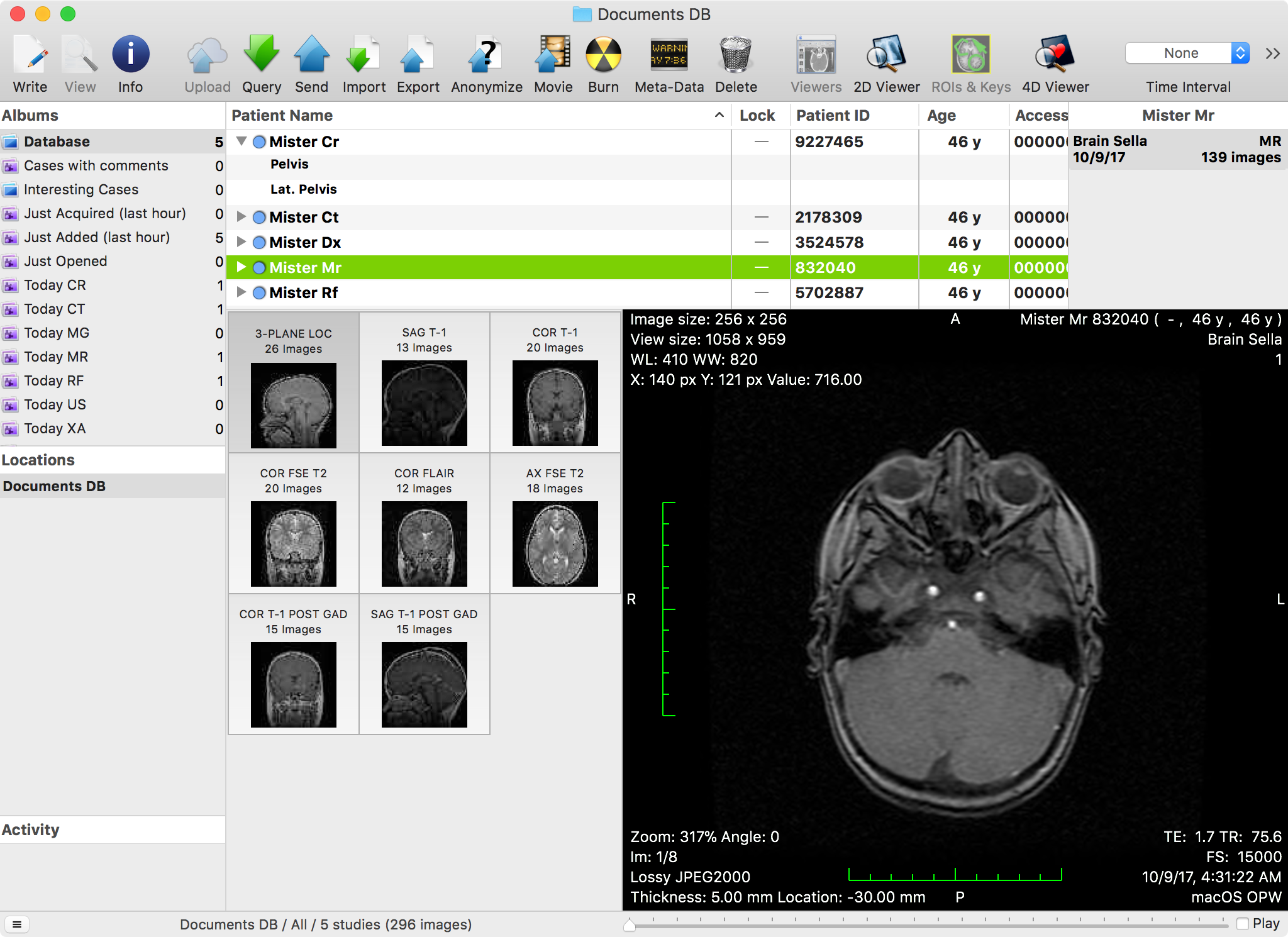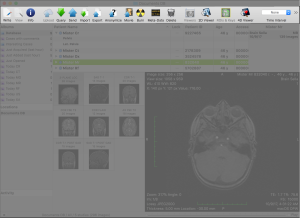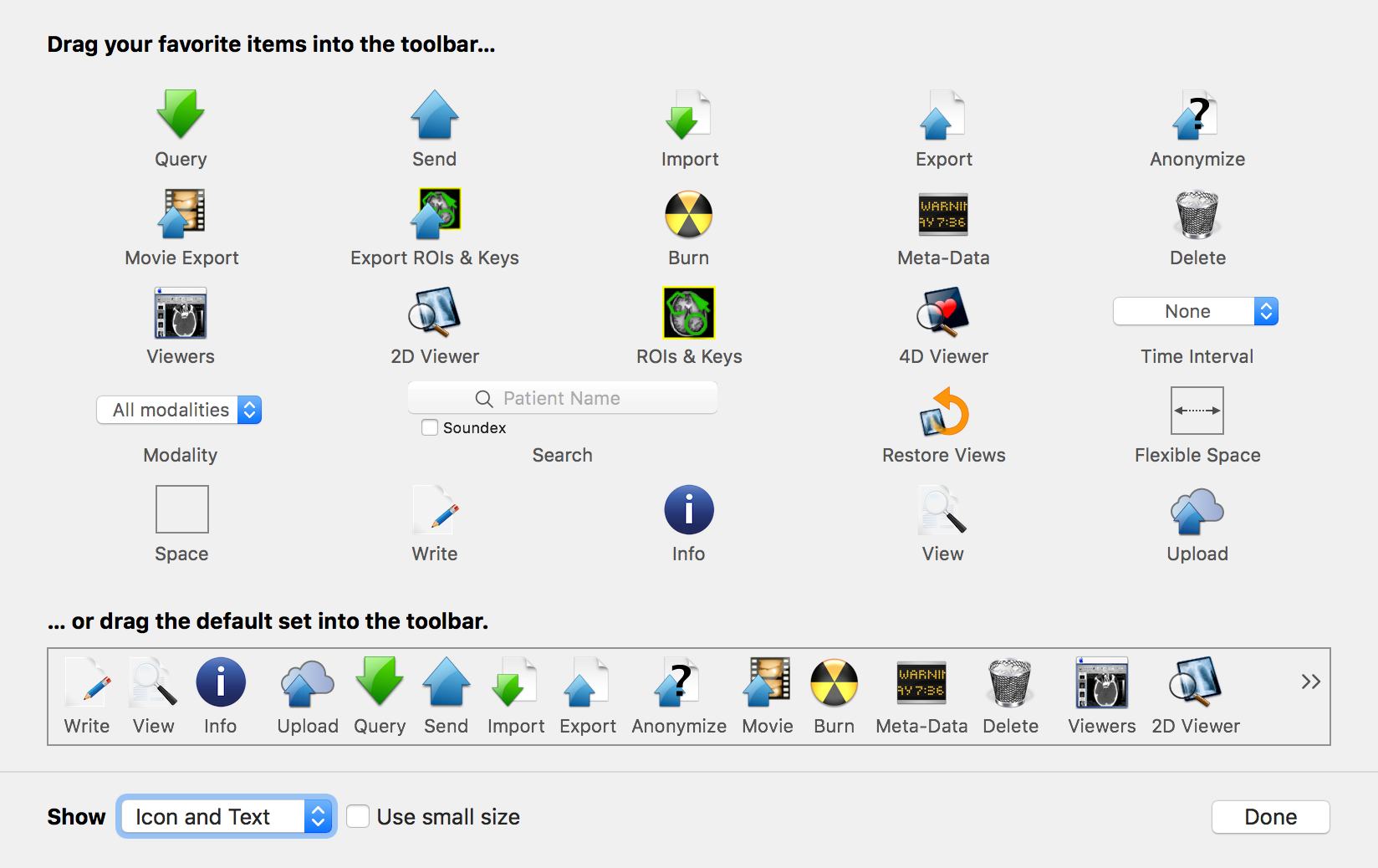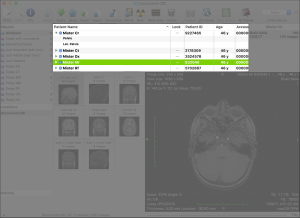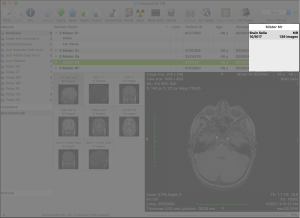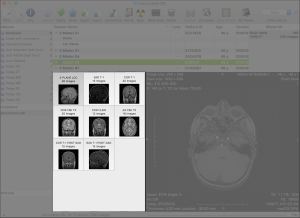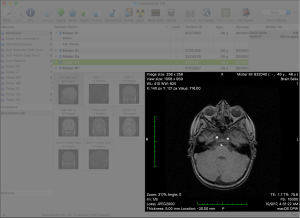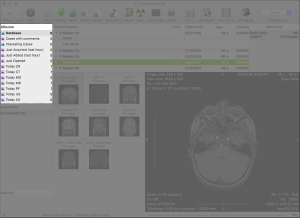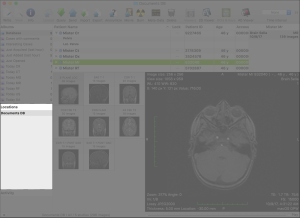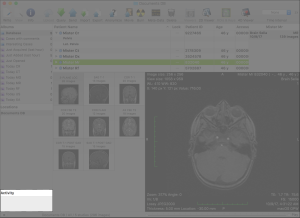The database window is the main window in OnePacs Workstation for macOS. The main purpose of this window is to allow you to access and manage the locally available datasets. When additional studies are imported, they appear in this window.
DICOM and XML-RPC communications are described in the dedicated pages.
Many customization options are available for the database window. In this page, all the customization options we mention are available in the Database preferences pane, unless otherwise indicated.
Graphical User Interface
The main portion of the window is dedicated to the datasets browser. In the studies table, data is organized in disclosable study items. To the right of the outline, the history list displays a list of studies that belong to the same patient as the selected items. The selected studies or series are displayed in more detail in the lower portion of the window, where a grid of thumbnails is displayed on the left side. The selected element in this grid is previewed in the lower right portion of the window. The size of these views can be adjusted by dragging the borders in between them.
As the application main window, the database window also provides quick access to other databases and DICOM nodes, and displays the status of background processes. These extra elements are available in the left portion of the window, along with the albums list.
At the top of the window, the toolbar allows you to access tools that interact with the displayed data. The bottom bar provides extra database information and tools.
The series parsing section of the preferences allows you to redefine how datasets are grouped into studies and series. You can also define how series and images are sorted in the series sorting and image sorting sections of the preferences. Other options are described in this page and in the data management section.
The Toolbar
The database window toolbar provides access to tools and functions that interact with the selected database item, with the database itself or with global elements of the application interface.
Depending on the use you make of OnePacs Workstation for macOS, some tools may be more useful to you than others. Consequently, you can customize the toolbar to choose with toolbar items are displayed and in what order. To customize the toolbar, right-click on the window titlebar background and select the Customize Toolbar... menu item.
This customization interface is a common user interface element in macOS and you should be familiar with it. It allows you to reorder and insert items by dragging them to the desired position or out of the toolbar to remove them.
In this section, we will review these toolbar items while grouping them by their purpose.
Search
This item allows you to filter the displayed studies by providing a string to match against the available items.
By enabling the soundex checkbox, the search mechanism will use an algorithm to also include phonetically matching items.
By clicking on the little loupe icon, you will be able to specify what item properties your string shall be matched against.
If an album is currently selected, an additional label will appear, telling you how many studies match in the complete database. By clicking on this label the album will be deselected and the whole database results will be displayed.
Modality
This item allows you to filter the displayed studies by their modality.
Time Interval
This item allows you to filter the displayed studies by their creation date.
2D Viewer
This button has the same effect as double-clicking an item in the studies table or the thumbnails grid, or double-clicking the preview: it opens a viewer displaying the selected series (the one that is displayed in the preview).
4D Viewer
This button parses the temporal data of the selected series and opens a viewer that allows both spatial and temporal browsing of the series.
ROIs & Keys
This button opens a viewer displaying the images in the selected series that are marked as key or contain ROIs.
Meta-Data
This button opens a meta-data browser for the selected image.
Query
This button opens the DICOM Query & Retrieve interface, allowing you to search the configured DICOM nodes for additional datasets.
Send
This button opens the DICOM Send interface, allowing you to send the selected datasets to a configured DICOM node.
Import
This button allows you to use the system files browser to import additional datasets.
Export
This button allows you to use the system file save browser to export the selected datasets.
Anonymize
This button opens the Anonymization interface, allowing you to specify what fields should be removed, inserted or modified, in the selected datasets.
Export ROIs & Keys
This button creates a DICOM file containing a record of all key image flags and ROIs in the selected datasets.
Upload
This button sends the selected datasets to your OnePacs account. It is only enabled if the selected study is recognized by the OnePacs system, and if the selected datasets aren't already stored on the OnePacs cloud. It requires a running and configured OnePacs Study Retriever app.
Burn
This button opens the CD/DVD burning interface, allowing you to store the selected datasets on a disk.
Movie Export
This button exports the current series as a movie file.
Delete
This button deletes the selected datasets.
Info
This button opens the information page for the selected item.
This button is only enabled if the selected study is recognized by the OnePacs system. It requires a running and configured OnePacs Study Retriever app.
View
This button opens the report for the selected item.
This button is only enabled if the selected study is recognized by the OnePacs system and if a report is available for it. It requires a running and configured OnePacs Study Retriever app.
Write
This button opens the report edition page for the selected item.
This button is only enabled if the selected study is recognized by the OnePacs system. It requires a running and configured OnePacs Study Retriever app.
Viewers
This button brings the open viewer windows to front.
Restore Views
This button rearranges the database window interface so all its elements are visible.
Space and Flexible Space
The system-defined space and flexible space items allow you to separate the toolbar items in groups.
The Studies Table
Studies and series are presented in a table. You should be familiar with this data presentation model, quite common in macOS apps and in the Finder itself: you may change the items order by clicking on the column headers, thus determining the new primary sorting key, marked with an arrow sign; by clicking on the current primary sorting key column header, you will invert the sorting order. By right-clicking on the table headers you can choose which columns should be displayed, and you can reorganize the order in which columns are arranged by dragging them to their desired position.
As discussed above, the series table can be filtered and searched.
Study items can be disclosed to display their series. By selecting items in the table, the represented objects are displayed in the thumbnails grid and consequently in the preview area. Double-clicking an item will open its represented dataset in a viewer window.
Most cells in this table display static textual information. Date cells display dates using the format specified in the preferences, where more options are available to customize the table presentation and behavior. Other cells may have other purposes, and can be interacted with:
- The Lock column cells can be clicked to toggle the item lock flag: locked items won't be removed by the database auto-cleaning mechanism;
- The Status column cells can be clicked to assign the item status property: available statuses are empty, unread, reviewed, dictated and validated;
- The Comments column cells (and Comments 2, 3 and 4) can be clicked to edit the comments.
The History List
The history list provides quick access to other studies that match the patient information of the selected dataset.
Additionally to the matching studies in the current database, the history also displays matches found on DICOM nodes configured in the On-Demand preferences. Remote studies are displayed using an italic font. If a remote match is found, containing more images than the local version of the same study, the remote item is displayed.
By double-clicking an item in this list, the corresponding dataset is transferred to the local database. Double-clicking a study that is already partially in the local database will retrieve the missing images.
The Thumbnails Grid
The thumbnails grid displays the content of the items currently selected in the studies table. When a study is selected, its series are displayed in this grid; when a series is selected, its images are displayed.
The object represented by the item selected in the grid is also displayed in the preview area. Double-clicking an item will open its represented dataset in a new viewer window.
The Preview Area
The preview area displays the dataset represented by the selected item in the thumbnails grid.
This view is a basic, stateless version of the viewer, where interaction is limited to spatial navigation: only zooming, panning, rotation and WL/WW adjustments are allowed through the default keyboard modifiers.
The Albums List
Albums are either user-defined filters (smart albums, displayed with a purple icon) or user-defined collections (plain albums, displayed with a blue icon). An extra item named Database, always available at the top of the list and selected by default, represents an empty filter.
Only studies that are in the selected album will be displayed in the studies table, with the additional rule that, if the corresponding option is enabled in the preferences, all other studies of a patient may be displayed if one study matches the filter rules. When the default Database album is selected, all studies are listed.
A set of predefined albums is created when opening a database that contains no albums. You can delete these albums and create your own through the Albums submenu in the File menu, or through the contextual menu, by right-clicking in the albums list.
The Locations List
This area lists known local databases, mounted volumes and network nodes (DICOM and shared database nodes).
By selecting items in this list you will switch the displayed datasets to those contained in the newly selected list. You can also transfer datasets to these nodes by dragging studies form the studies list to the to the destination item in this list.
But not all items are selectable, and not all items are valid destinations. The following table clarifies the purpose of the node types.
| Is Selectable | Is Valid Destination | |
|---|---|---|
| Local Databases | Yes | Yes |
| DICOM Nodes | No | Yes |
Shared Database Nodes | Yes | Yes |
| Mounted DICOM Volumes | Yes | No |
You can edit this list in the Locations preferences. You can also configure the app to sync the different node types lists with a shared document.
The Activity List
The activity area displays the status and progress of background tasks, e.g. DICOM communications.
Certain tasks allow you to signal them to abort their process. For these tasks, a cancel button is displayed in the top-right corner of the corresponding cell. Cancelling a task doesn't necessarily instantly remove it from the list: items are only removed when the related process completes.
The Bottom Bar
The bottom bar is split in three sections. In the left edge, a button allows you to toggle the visibility of the left bar (the albums, locations and activity lists). In the right side, under the preview area, a scrollbar allows you to scroll the previewed series, and a checkbox allows you to toggle its automatic progress. In the middle, you can read some statistics about the loaded database.
Data Management
Generally speaking, the database window displays the contents of a database. By default, the app creates and loads a database from the user's home folder: more precisely, the default database location is ~/Documents/OnePacs Workstation Data (the tilde sign represents the user home folder location). Users can change the default database location in the preferences.
Data inside the database folder is organized by the app and should not be touched by the user. If you delete, rename or move files or directories in database folders, the app may not be able to access its data anymore, and you may experience data and volume space losses.
OnePacs Workstation for macOS is mainly a DICOM viewer, but other image formats are also supported, i.e. the JPEG and TIFF formats. If you want, you can configure the app to only handle DICOM datasets, and the app will ignore other file formats. When importing archive files (e.g. ZIP files), the app will unarchive them and import the resulting files that are in the supported formats.
To add files to the database, use the Import toolbar item or the corresponding File menu item, or drag them into the database window or into the app dock icon. When manually adding datasets to a database, you can decide if you want to copy these files into the database or if you want the database to keep references to their location. The preferences allow you to choose either behavior, or to always be asked. Datasets added through DICOM communication are always stored in the database. Datasets that are stored externally can later be copied into the database folder through the dedicated File menu item.
Local files can be imported as raw data, allowing you to manually provide information about how they should be indexed in the database. The app also allows you to add datasets by specifying a storage URL. The URL will be accessed, and the data will be added to the database after the download.
Image Compression
OnePacs Workstation for macOS can display images encoded using all standard DICOM compression techniques. Lossless compression is 100% reversible, meaning that when the image is uncompressed for display, the resulting image is exactly the same as the original (prior to compression). Lossy compression doesn't guarantee this. As the name implies, lossy compression is not reversible, and involves some loss in quality. Generally, the amount of quality lost is proportional to the amount of compression applied.
You may choose to compress images to free up local storage space, or to decompress them to speed up dataset loading. The app allows you to do so manually, through the File menu items, or automatically when adding datasets (configured in the Database preferences). The default behavior is to store data as its original format. If you decide to compress data, you may choose a lossless compression algorithm.
Auto-Cleaning
If you use OnePacs Workstation for macOS over a long period or intensively, you may run out of storage space. To avoid this problem, the app offers an auto-cleaning mechanism: if enabled, when a certain storage space threshold is reached, the app will start deleting datasets from the database.
The auto-cleaning section of the preferences allows you to define this storage space threshold and the datasets deletion criteria.
Anonymization
You can remove personal information from DICOM values. The anonymization interface, reachable through the Anonymize toolbar item and File menu item, allows you to specify which DICOM tags should be removed, modified or added. You can export the resulting dataset to a custom location or add it to your local database, optionally deleting the original items.
Exporting
The app allows you to export datasets to different formats. The JPEG and TIFF file formats are supported for exporting images. The file format for movie exporting is MP4. You can convert the exported files to other formats using eternal tools. Additionally, you can export the displayed image directly to your Photos library, or attach it to a new Mail message.
These functions are also reachable directly from within the viewers, but their availability varies, depending on the viewer type.
The app also allows you to create DICOM CD/DVDs or disk images from a dataset selection. In the database window, select the intended datasets, then launch the burning interface through the Burn toolbar item or the File menu item. A dedicated interface will appear, allowing you to specify how the data should be formatted, and to save the resulting volume as a disk image or to burn it.
